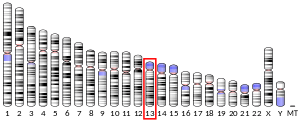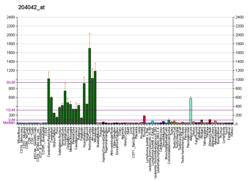WASF3
Wiskott-Aldrich syndrome protein family member 3 is a protein that in humans is encoded by the WASF3 gene.[5][6]
This gene encodes a member of the Wiskott-Aldrich syndrome protein family. The gene product is a protein that forms a multiprotein complex that links receptor kinases and actin. Binding to actin occurs through a C-terminal verprolin homology domain in all family members. The multiprotein complex serves to tranduce signals that involve changes in cell shape, motility or function.[6]
References
- 1 2 3 GRCh38: Ensembl release 89: ENSG00000132970 - Ensembl, May 2017
- 1 2 3 GRCm38: Ensembl release 89: ENSMUSG00000029636 - Ensembl, May 2017
- ↑ "Human PubMed Reference:".
- ↑ "Mouse PubMed Reference:".
- ↑ Suetsugu S, Miki H, Takenawa T (Jul 1999). "Identification of two human WAVE/SCAR homologues as general actin regulatory molecules which associate with the Arp2/3 complex". Biochem Biophys Res Commun. 260 (1): 296–302. doi:10.1006/bbrc.1999.0894. PMID 10381382.
- 1 2 "Entrez Gene: WASF3 WAS protein family, member 3".
Further reading
- Jones GE (2000). "Cellular signaling in macrophage migration and chemotaxis". J. Leukoc. Biol. 68 (5): 593–602. PMID 11073096.
- Nakajima D, Okazaki N, Yamakawa H, et al. (2003). "Construction of expression-ready cDNA clones for KIAA genes: manual curation of 330 KIAA cDNA clones". DNA Res. 9 (3): 99–106. doi:10.1093/dnares/9.3.99. PMID 12168954.
- Schott DR, Chang JN, Deng G, et al. (1994). "A candidate tumor suppressor gene in human breast cancers". Cancer Res. 54 (6): 1393–6. PMID 8137235.
- Bonaldo MF, Lennon G, Soares MB (1997). "Normalization and subtraction: two approaches to facilitate gene discovery". Genome Res. 6 (9): 791–806. doi:10.1101/gr.6.9.791. PMID 8889548.
- Bear JE, Rawls JF, Saxe CL (1998). "SCAR, a WASP-related protein, isolated as a suppressor of receptor defects in late Dictyostelium development". J. Cell Biol. 142 (5): 1325–35. doi:10.1083/jcb.142.5.1325. PMC 2149354. PMID 9732292.
- Nagase T, Ishikawa K, Suyama M, et al. (1999). "Prediction of the coding sequences of unidentified human genes. XII. The complete sequences of 100 new cDNA clones from brain which code for large proteins in vitro". DNA Res. 5 (6): 355–64. doi:10.1093/dnares/5.6.355. PMID 10048485.
- Marchand JB, Kaiser DA, Pollard TD, Higgs HN (2001). "Interaction of WASP/Scar proteins with actin and vertebrate Arp2/3 complex". Nat. Cell Biol. 3 (1): 76–82. doi:10.1038/35050590. PMID 11146629.
- Millard TH, Machesky LM (2001). "The Wiskott-Aldrich syndrome protein (WASP) family". Trends Biochem. Sci. 26 (3): 198–9. doi:10.1016/S0968-0004(01)01788-1. PMID 11246027.
- Sossey-Alaoui K, Su G, Malaj E, et al. (2002). "WAVE3, an actin-polymerization gene, is truncated and inactivated as a result of a constitutional t(1;13)(q21;q12) chromosome translocation in a patient with ganglioneuroblastoma". Oncogene. 21 (38): 5967–74. doi:10.1038/sj.onc.1205734. PMID 12185600.
- Strausberg RL, Feingold EA, Grouse LH, et al. (2003). "Generation and initial analysis of more than 15,000 full-length human and mouse cDNA sequences". Proc. Natl. Acad. Sci. U.S.A. 99 (26): 16899–903. doi:10.1073/pnas.242603899. PMC 139241. PMID 12477932.
- Sossey-Alaoui K, Head K, Nowak N, Cowell JK (2003). "Genomic organization and expression profile of the human and mouse WAVE gene family". Mamm. Genome. 14 (5): 314–22. doi:10.1007/s00335-002-2247-7. PMID 12856283.
- Dunham A, Matthews LH, Burton J, et al. (2004). "The DNA sequence and analysis of human chromosome 13". Nature. 428 (6982): 522–8. doi:10.1038/nature02379. PMC 2665288. PMID 15057823.
- Oda A, Miki H, Wada I, et al. (2005). "WAVE/Scars in platelets". Blood. 105 (8): 3141–8. doi:10.1182/blood-2003-04-1319. PMID 15280206.
- Kashiwagi H, Shiraga M, Kato H, et al. (2005). "Expression and subcellular localization of WAVE isoforms in the megakaryocyte/platelet lineage". J. Thromb. Haemost. 3 (2): 361–8. doi:10.1111/j.1538-7836.2004.01082.x. PMID 15670045.
- Stovold CF, Millard TH, Machesky LM (2006). "Inclusion of Scar/WAVE3 in a similar complex to Scar/WAVE1 and 2". BMC Cell Biol. 6: 11. doi:10.1186/1471-2121-6-11. PMC 555569. PMID 15752430.
- Sossey-Alaoui K, Li X, Ranalli TA, Cowell JK (2005). "WAVE3-mediated cell migration and lamellipodia formation are regulated downstream of phosphatidylinositol 3-kinase". J. Biol. Chem. 280 (23): 21748–55. doi:10.1074/jbc.M500503200. PMID 15826941.
- Sossey-Alaoui K, Ranalli TA, Li X, et al. (2005). "WAVE3 promotes cell motility and invasion through the regulation of MMP-1, MMP-3, and MMP-9 expression". Exp. Cell Res. 308 (1): 135–45. doi:10.1016/j.yexcr.2005.04.011. PMID 15907837.
This article is issued from
Wikipedia.
The text is licensed under Creative Commons - Attribution - Sharealike.
Additional terms may apply for the media files.




